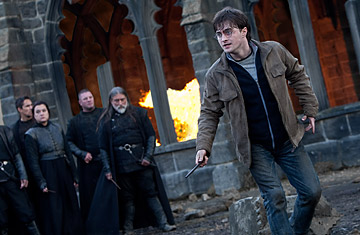
A scene from Harry Potter and the Deathly Hallows Part 2
(2 of 2)
The battle scenes are finely etched and boldly presented; yet the heart of DH2, as in the earlier films, is found in more intimate exchanges involving the amazing cadre of British acting royalty enlisted for the enterprise. You see this in the first scenes, as Harry interrogates the goblin Griphook and the wand merchant Ollivander, momentarily his prisoners. Griphook (Warwick Davis, who also plays Professor Filius Flitwick) is immaculately coiffed, with long, mud-colored fingernails, and endures the grilling with the imperial balkiness of a king kidnapped from a small kingdom and treated without due respect in a larger one. His agreement to help Harry, Ron and Hermione sneak into the innermost vault of Gringotts Bank is presented as a negotiation of weight and delicacy. As Ollivander, who must reveal the import of two wands in Harry's possession, John Hurt lends portentous weight and a sad charm to every syllable. It's a marvelous cameo performance, out-wonderfulled only by Gambon's grave majesty and Rickman's slow, pearly elocution and his depiction of Snape's emergence from a crusty shell into another sort of majesty.
The bank heist, beginning in the cool marble of the Gringotts counting room, is splendidly realized. Hermione must pretend to be the mean matron Bellatrix Lestrange; and Helena Bonham Carter, who plays Bellatrix, has fun impersonating Watson impersonating her. Inside the vault (after a Temple of Doom–style roller-coaster ride that briefly breaks the Potter tone), the interlopers find that every cup they touch multiplies ad infinitum, until the room is clogged to the ceiling with a Vatican's worth of precious metals. How are our heroes to escape, once Griphook sneaks out and armed guards approach? On the back of the vault's truculent sentry, a huge dragon, which clambers through underground passages to emerge in the counting room with the kids hanging on. The film allows the dragon its own precious character moment: crashing through the Gringotts cupola, the great creature pauses for a second to savor its freedom before flapping its torn papier-mâché wings, soaring low and kicking a few chimney tops into rubble, then ascending to lift its passenger-saviors into the sky. This thrilling sequence is an apt metaphor for the entire film series: at first a bit clumsy in transferring Rowling's vision into movies, then gaining strength, finding its wing power and soaring in later episodes.
Many critics have defined the books as a story of love after death: Harry for his parents, Harry for Dumbledore, even a certain serpentine teacher for a young woman whose ardent memory he will spend his life cherishing and protecting. But the books and the films also deal with a matter close to the young: Which adults can I trust? Who deserves my loyalty and obedience? We know from earlier episodes that Voldemort is simply evil, Dumbledore complicatedly wise and good. In the finale, we see, in sudden clarity, the murky motives of another father figure. The change provides the film's most throbbing revelation: a bereft wizard holding the lifeless body of his beloved, as, behind this plangent Pietà, a 1-year-old child sobs. The scene gives evidence that, of the story's several heroes, Harry has not sacrificed the most.
Though something like 94% of the people about to see DH2 must know the fate of Harry, his steadfast friends and his purported enemies, I am tiptoeing and sidestepping as I describe certain scenes. That's because, like any child wanting to know what happens next in a story at bedtime, I want to know at the right time and wouldn't care to spoil the suspense for the uninitiated. I consumed Rowling's first three volumes in a ravenous week or so back in the summer of 1999 yet held off reading the conclusion of Deathly Hallows until last fall, after I'd reviewed the first half-movie made from it. At the end, I confess, I felt like Rowling, who said about finishing her monument of writing, "I never dreamed I could feel simultaneously heartbroken and euphoric." For me, the end was just as powerful, transporting and sad.
Readers who responded as fully I did to the book are unlikely to feel the same convulsive emotions watching the end of DH2. For one thing, they've already been there; the movie cannot be more than a zealous approximation of Rowling's achievement, a fair copy of a rapturous literary experience. Yet Yates and his team offer enough visual epiphanies — Snape's inky shape as he flies through a closed window, a ravaging fire that assumes the shape of Voldemort's pet snake Nagini, the lovely, ethereal gravity of Helena the Grey Lady (Kelly Macdonald), the white tears shed by a dying teacher — to bring the pages alive onscreen. The sublime supporting cast, brought back if only for glimpses here, remind us that the series is a luscious, perhaps unparalleled showcase for this generation's most endearing British actors. And the children, now adults, in the main roles have matured ably along with their characters.
On both sides of the camera, all have performed inventively and honorably, faithful servants to the wizard in chief, Joanne Rowling. And now we must say goodbye to this world, like a summer camp we attended from childhood through adolescence and can return to only in memory — or, someday, with our children on DVD. Hail and farewell, Harry Potter films. You strove to do good and did better. In the wizarding world and the epic-movie universe, all is well.
